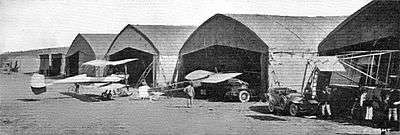Bessonneau hangar

The Bessonneau hangar was a portable timber and canvas aircraft hangar used by the Royal Flying Corps during World War I.
History
In about 1908, the Bessonneau hangar was designed and manufactured by the French rope and canvas manufacturer Etablissements Bessonneau, headed by Julien Bessonneau (1842–1916) and based at Angers. The hangar, then referred to as a Bessonneau tent, was first used in the area of Maine-et-Loire, and in 1910 specifically employed to protect aircraft participating in a race from Angers to Saumur. In World War I, the design was adopted by the Royal Flying Corps (RFC) to house aircraft in both Great Britain and France. From about 1917, Bessonneau hangars were increasingly used for temporary protection for RFC aircraft pending construction and development of permanent hangars. They were also extensively used at RFC Aircraft Acceptance Parks, where aircraft were assembled and tested before delivery, and for squadrons that moved from Britain to advancing battlefronts in France. After World War I, Bessonneau hangars were often used for cheap and portable storage for civilian aircraft and the Royal Air Force continued to employ these hangars into World War II, later designating them 'Aircraft Hangar (Type H)' and defined by Air Publication AP.4488A.[1] After World War II, British military use of Bessonneau hangars continued for the purpose of storing powered aircraft and gliders operated by the Air Training Corps ('Air Cadets'), until about 1990 and the last spare parts were disposed of by RAF Stafford c.1988. A few Bessonneau hangars then briefly survived with gliding clubs for military personnel at airfields such as Kenley, but they typically succumbed to bad weather - as happened to one of the last survivors at RAF Odiham c.2010 - and inadequate maintenance and support.[2] No complete Bessonneau hangars are known to survive today.
Construction
The hangar was supplied as a kit of parts that could be easily erected, dismantled, transported and re-erected at another location. The principal material of the framework was wood, joined by wooden plates, steel brackets and steel bolts. Vertical stanchions supported roof trusses, with extensively triangulated ties and beams. Bays (units) of stanchions and trusses were built up and connected to each other, with each hangar assembled with 6, 9 or 12 bays to achieve different hangar lengths. Wooden flying buttresses were applied to the sides and rear, to ensure rigidity, and ropes were used to tie down the whole structure onto steel pickets driven into the ground. Snow poles were attached to the underside of selected trusses, and hinged to allow them to be lowered for extra roof support in the event of heavy snow or high winds. The tailored canvas covering was tied to the framework with ropes.[3]
Over 1000 covers were made for the hangars at Messrs Paull & Co in Martock, Somerset[4]
The most common variant in Britain was the 6-bay design, providing inside clear dimensions of width (span) 20 metres (65 ft 6 in), length 24 metres (79 ft) and height 4 metres (13 ft 2 in). Outside dimensions were width 22 metres (72 ft), length 28 metres (91 ft 10 in), height 7.7 metres (25 ft 5 in), excluding picketing ropes.[3]
References
- ↑ English Heritage thesaurus English Heritage Archived July 18, 2011, at the Wayback Machine.
- ↑ Predannack hangar 626vgs.co.uk Archived January 19, 2010, at the Wayback Machine.
- 1 2 AP.4488A description kestrel-gliding.org.uk
- ↑ Martock & The Great War by the Rev. George W. Saunders, published 1920, Page 4 - accessed from www.genealogyhelp.co.uk 1st Feb 2011
External links
- Corpus Historique Etampois (fr) corpusetampois.com
- Histoire du Bessonneau (fr) aircollection.pagesperso-orange.fr
- AP.4488A ch.1 kestrel-gliding.org.uk
- AP.4488A ch.2 kestrel-gliding.org.uk
- AP.4488A ch.3 kestrel-gliding.org.uk
- AP.4488A ch.4 kestrel-gliding.org.uk
- AP.4488A app.1 kestrel-gliding.org.uk
- AP.119M-0104-5F kestrel-gliding.org.uk
- Images & AP.4488A pages kestrel-gliding.org.uk
- Bessonneau hangars at Duxford 1918 https://web.archive.org/web/20110629023415/http://dspace.dial.pipex.com/town/place/gdg18/firstworldwar.htm
- Bessonneau hangar at Guernsey 1917 greatwarci.net
- Bessonneau hangars in Canada 1920 bombercommandmuseum.ca